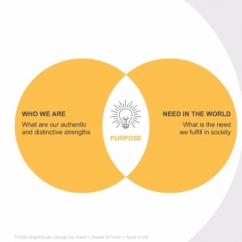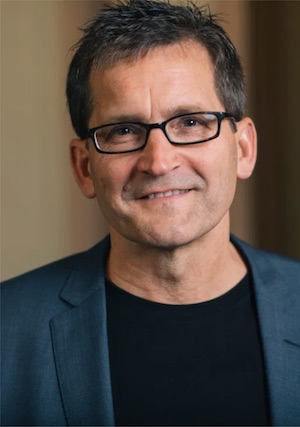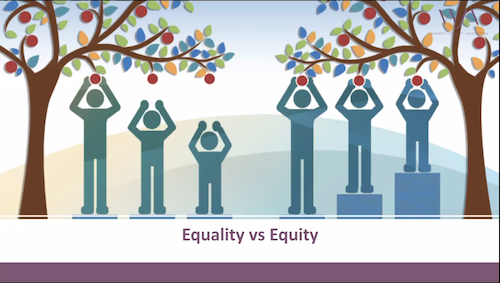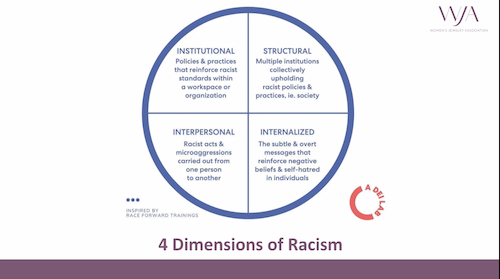Articles and News
The Purpose-Driven Business, Plus Understanding Diversity And Transformation | July 29, 2020 (0 comments)

New York, NY—Like everything else this year, the Women’s Jewelry Association’s annual Awards For Excellence looked very different. Image: Speaker Dolly Meese used this graphic to explan how to find purpose.
Normally, the dinner is one of the industry’s biggest see-and-be-seen gala events; a can’t-miss evening overlooking the Hudson River in New York City. This year, however, attendees swapped out glam gowns and gorgeous jewels for comfy loungewear, and logged into Zoom to learn instead of laud.
Instead of its traditional awards, WJA presented an educational evening themed “Leading Through Transformation.” Keynote speakers were Jim Hemerling and Dolly Meese of Boston Consulting Group. Hemerling, a senior partner, managing director, and fellow at Boston Consulting Group, has a focus on transforming organizations to deliver and sustain breakthrough performance. He addressed how businesses can move beyond short-term results and create a culture of sustainable, holistic performance. Meese, is global head of offerings and managing director of BCG subsidiary BrightHouse, addressed the importance of bringing purpose to your business. The keynotes were followed by two separate online discussions: one focusing on diversity, equity, and inclusion and the other on mentoring. The evening was sponsored by the Natural Diamond Council, Boston Consulting Group, Citizen Watch America, Forevermark, Jewelers of America, AGTA, Allure Gems, and Smiling Rocks.
The organization also kicked off its annual silent auction, normally a highlight of the in-person evening, and a key fundraiser for the WJA Foundation, which funds the organization’s scholarship program. This year’s auction also moved online and will run until August 4. Click here to see the items and make a bid.
A critical part of business success is having purpose, explained Dolly Meese, one of the two keynote speakers. People are meaning-seeking creatures, starting from childhood when we constantly ask “why?”
But business owners often confuse mission with purpose. Your mission is what you do—but purpose is whyyou do it. Your vision, meanwhile, is the strategy you employ to get to where you want to be.
“Your mission can change but purpose is like a precious stone: it doesn’t change,” said Meese.

Dolly Meese
How to find purpose? Meese says the point where your talents and the needs of the world intersect, there lies your calling. For an individual, what do your friends always ask your advice for? As a company, what’s your distinctive strength? Those super-strengths are what help us identify how to make the world a better place.
But why must we make the world a better place? Apart from it simply being the right thing to do, it also makes business sense.
“Purpose-driven companies are more likely than profit-driven companies to have high total shareholder return over 10 years, than those companes that don’t articulate [a purpose],” she said. They’re also more likely to attract and keep highly talented, productive employees.
“Employees inspired by purpose are 2-1/4 times more productive than employees who are merely satisfied,” she concluded.
Hemerling, meanwhile, said that COVID-19 has hit business and society with a force not seen since WWII. “Many of us are still fighting to flatten the curve and protect our families and employees. But we’re also finding business leaders looking forward, and how to transform out of COVID and beyond.
He used Microsoft as an example. While successful—with a $300 billion market capitalization—the company had a terrible reputation as a place to work until CEO Satya Nadella launched a full-on transformation in 2014. Afterwards, it rocketed to $106 trillion—with a T—after Nadella took a humanistic approach to transformation. It’s a combination of head, hands, and heart, he said. You can’t just dictate a company culture; you have to live it fully and make sure that your leadership team is fully aligned and committed. Only then can you communicate a compelling case for change.

Jim Hemerling
Finally, diversity consultant Nicole Taylor and Morgan Miller, senior account executive at the Couture Show, discussed the differences between diversity, equity, equality, and inclusion. This timely topic is especially relevant to WJA, which was founded to help women advance in an industry that often discriminated against them (and still does with surprising frequency).
Related: Building A Culture of Inclusion - Upcoming JVC Webinar
“Equality only works if someone starts in the same place. Equity, however, is about proportional resources. It creates a more balanced aspect to the equation,” explained Miller, who is Black.

Racism, meanwhile, is not always something we can pick up on, said Taylor, who also is Black. Sometimes it’s overt but many times it’s covert or microagressions. Her chart shows four dimensions of racism:

“You have to create a brave space, what I call ‘oops and ouch,’ said Taylor. "Oops is the moment when you say something hurtful, no matter how well intentioned. Intent is irrelevant," she says. If what you said came off as hurtful, you need to pause in the moment, own the “oops” and apologize. Conversely, if someone says something that’s hurtful to you, you must tell them and give them a chance to apologize and recognize it and grow. None of those conversations are easy but they are essential, she said.







